ECU OLDSMOBILE SILHOUETTE 2003 User Guide
[x] Cancel search | Manufacturer: OLDSMOBILE, Model Year: 2003, Model line: SILHOUETTE, Model: OLDSMOBILE SILHOUETTE 2003Pages: 466, PDF Size: 21.55 MB
Page 66 of 466
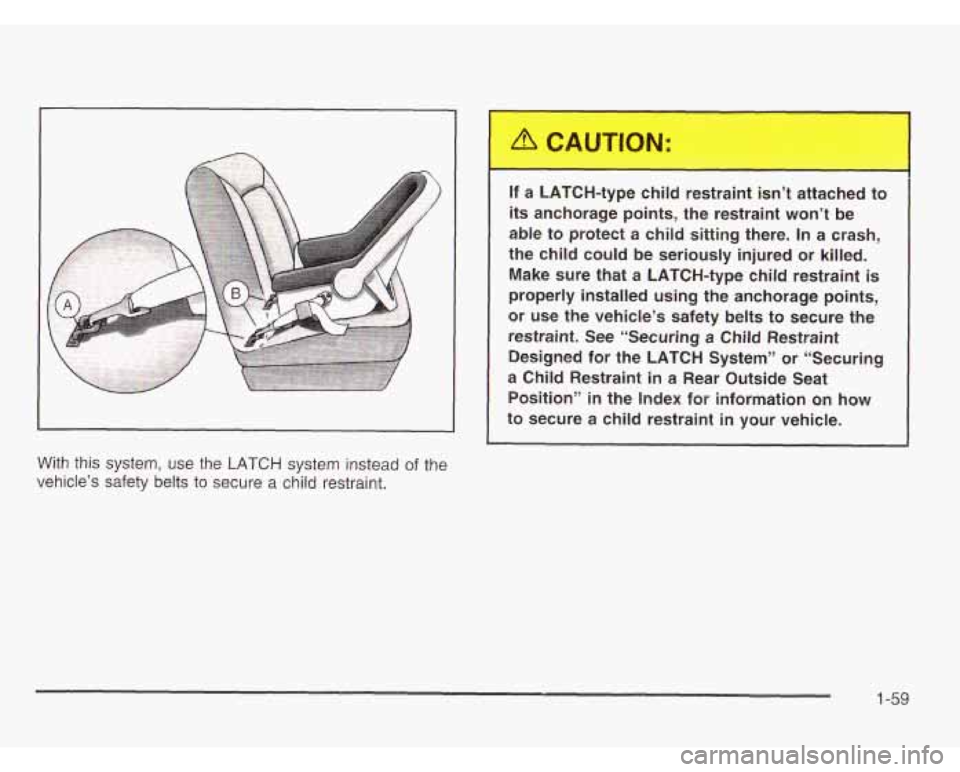
With this system, use the LATCH system instead of the
vehicle’s safety belts
to secure a child restraint. If a
LAT4-type child restraint isn’t attached to
its anchorage points, the restraint won’t be
able to protect
a child sitting there. In a crash,
the child could be seriously injured or killed. Make sure that a LATCH-type child restraint
is
properly installed using the anchorage points,
or use the vehicle’s safety belts to secure the
restraint. See “Securing a Child Restraint
Designed for the LATCH System’’ or “Securing
a Child Restraint
in a Rear Outside Seat
Position”
in the Index for information on how
to secure a child restraint
in your vehicle.
1 -59
Page 67 of 466
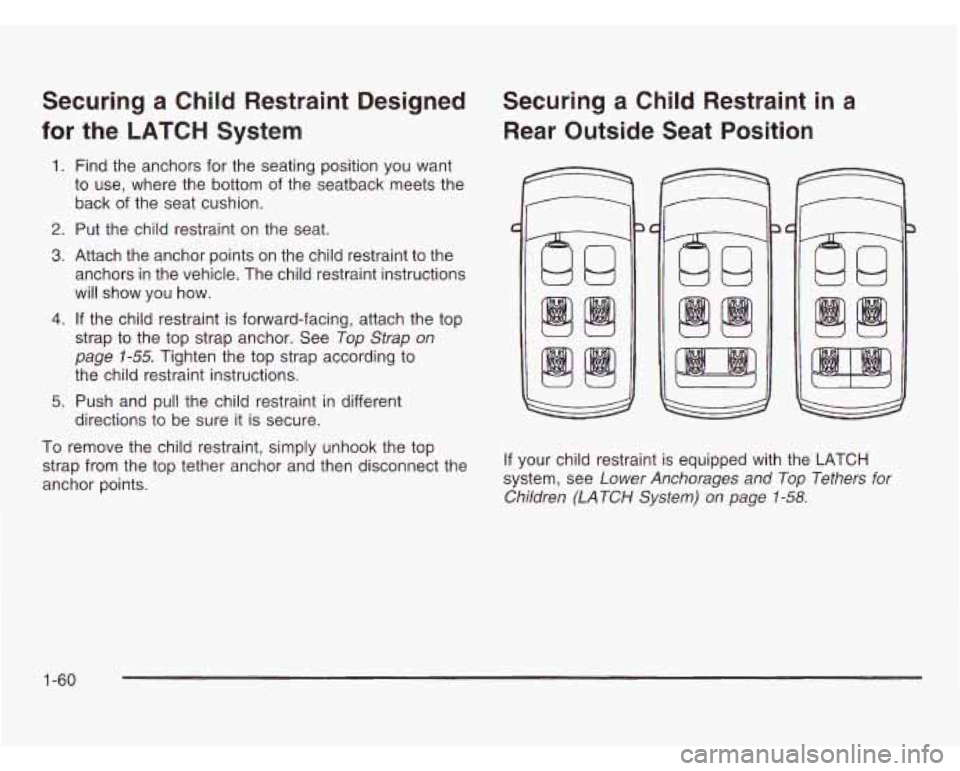
Securing a Child Restraint Designed
for the LATCH System
1. Find the anchors for the seating position you want
to use, where the bottom of the seatback meets the
back of the seat cushion.
2. Put the child restraint on the seat.
3. Attach the anchor points on the child restraint to the
anchors in the vehicle. The child restraint instructions
will show you how.
4. If the child restraint is forward-facing, attach the top
strap to the top strap anchor. See
Top Strap on
page 1-55. Tighten the top strap according to
the child restraint instructions.
5. Push and pull the child restraint in different
directions to be sure it is secure.
To remove the child restraint, simply unhook the top
strap from the top tether anchor and then disconnect the
anchor points.
Securing a Child Restraint in a
Rear Outside Seat Position
1
I
If your child restraint is equipped with the LATCH
system, see
Lower Anchorages and Top Tethers for
Children
(LATCH System) on page 1-58.
3
1 -60
Page 68 of 466
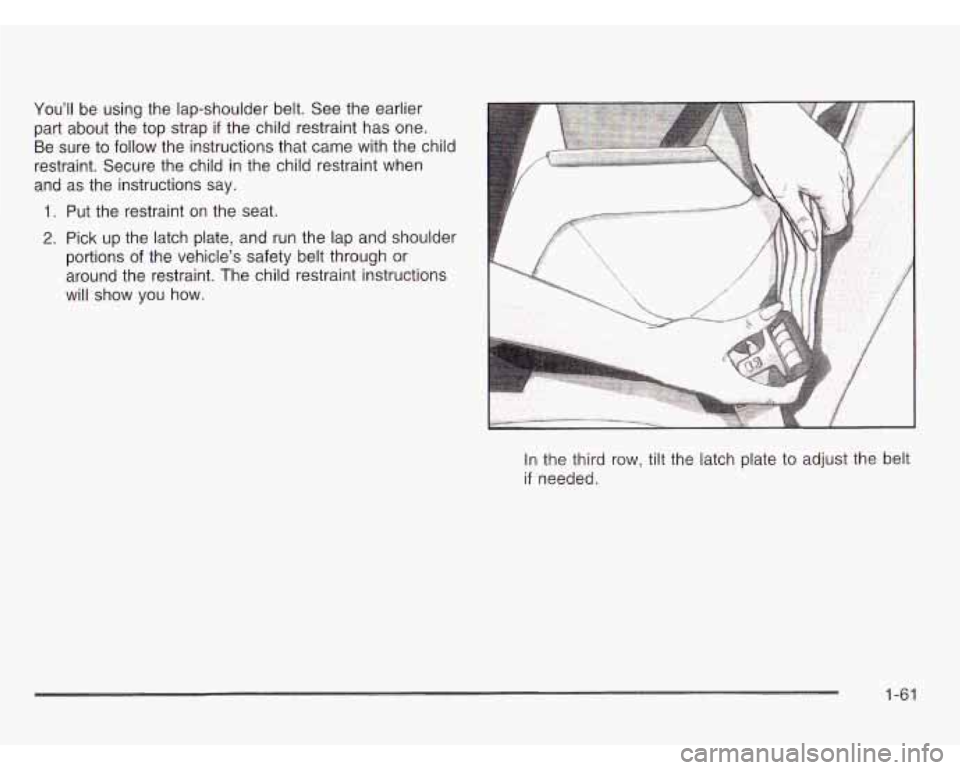
You’ll be using the lap-shoulder belt. See the earlier
part about the top strap
if the child restraint has one.
Be sure to follow the instructions that came with the child
restraint. Secure the child in the child restraint when
and as the instructions say.
1.
2.
Put the restraint on the seat.
Pick up the latch plate, and run the lap and shoulder
portions
of the vehicle’s safety belt through or
around the restraint. The child restraint instructions
will show you how.
In the third row, tilt the latch plate to adjust the belt
if needed.
1-61
Page 70 of 466
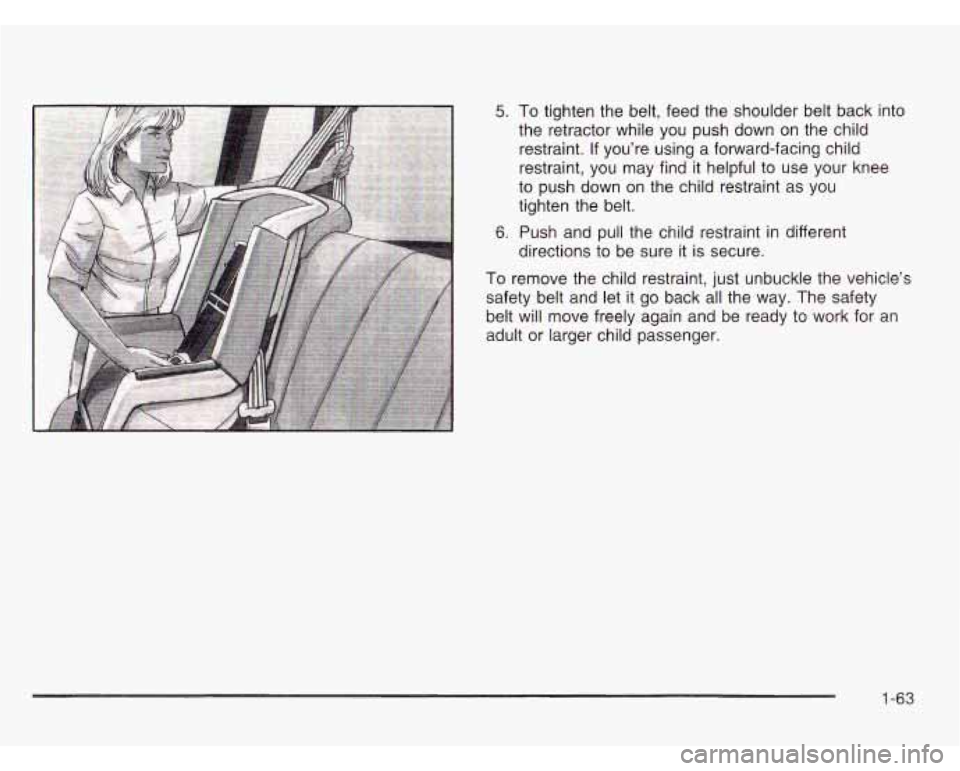
5.
6.
To tighten the belt, feed the shoulder belt back into
the retractor while you push down on the child
restraint. If you’re using a forward-facing child
restraint, you may find it helpful to use your knee
to push down on the child restraint as you
tighten the belt.
Push and pull the child restraint in different
directions to be sure it
is secure.
To remove the child restraint, just unbuckle the vehicle’s
safety belt and let it go back all the way. The safety
belt will move freely again and be ready to work for an
adult or larger child passenger.
1-63
Page 71 of 466
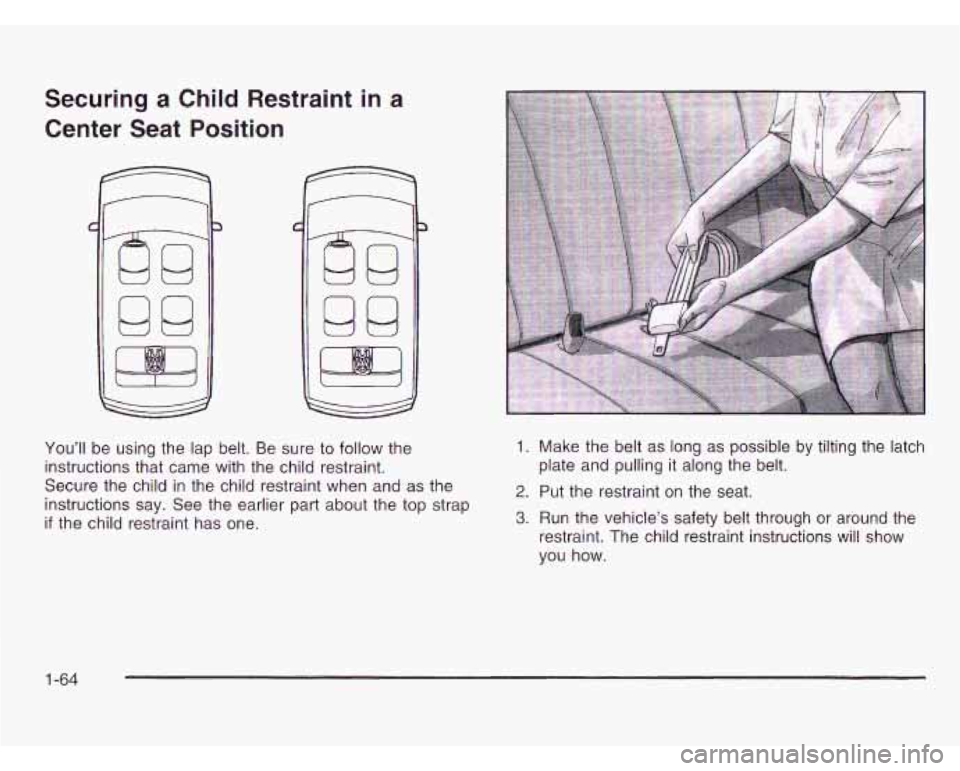
Securing a Child Restraint in a
Center Seat Position
3
You’ll be using the lap belt. Be sure to follow the
instructions that came with the child restraint.
Secure the child in the child restraint when and as the
instructions say. See the earlier part about the top strap
if the child restraint has one.
1.
2.
3.
Make the belt as long as possible by tilting the latch
plate and pulling it along the belt.
Put the restraint on the seat.
Run the vehicle’s safety belt through or around the
restraint. The child restraint instructions will show
you how.
1-64
Page 72 of 466
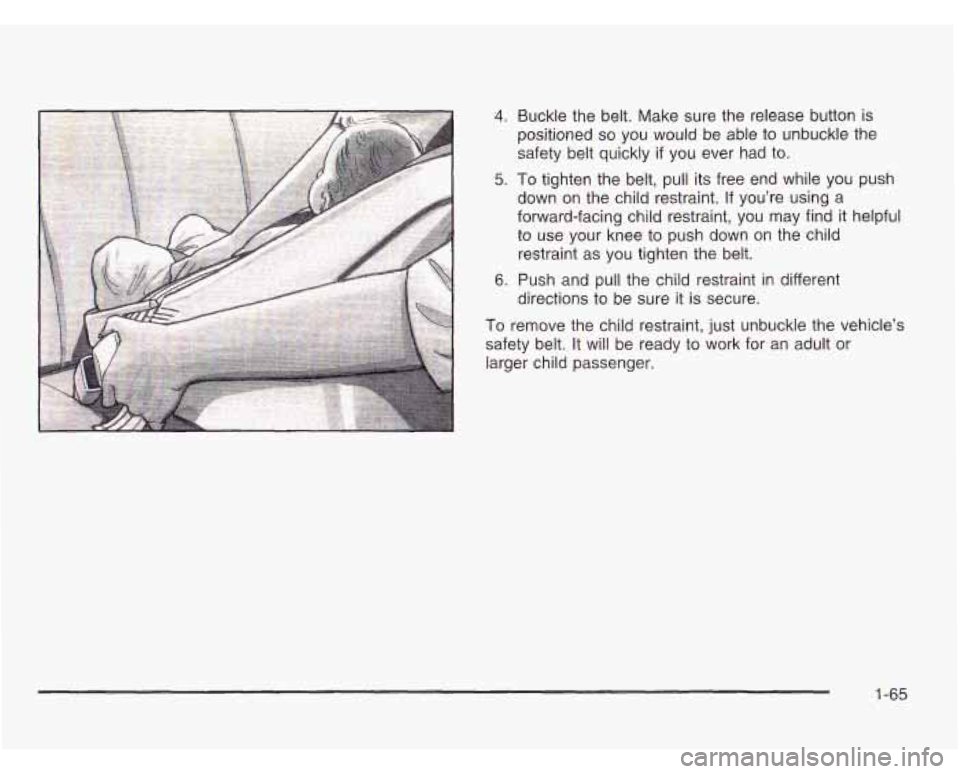
4. Buckle the belt. Make sure the release button is
positioned
so you would be able to unbuckle the
safety belt quickly if you ever had to.
5. To tighten the belt, pull its free end while you push
down on the child restraint.
If you’re using a
forward-facing child restraint, you may find it helpful
to use your knee to push down on the child
restraint as you tighten the belt.
6. Push and pull the child restraint in different
directions to be sure it is secure.
To remove the child restraint, just unbuckle the vehicle’s
safety belt. It will be ready to work for an adult or
larger child passenger.
1-65
Page 73 of 466
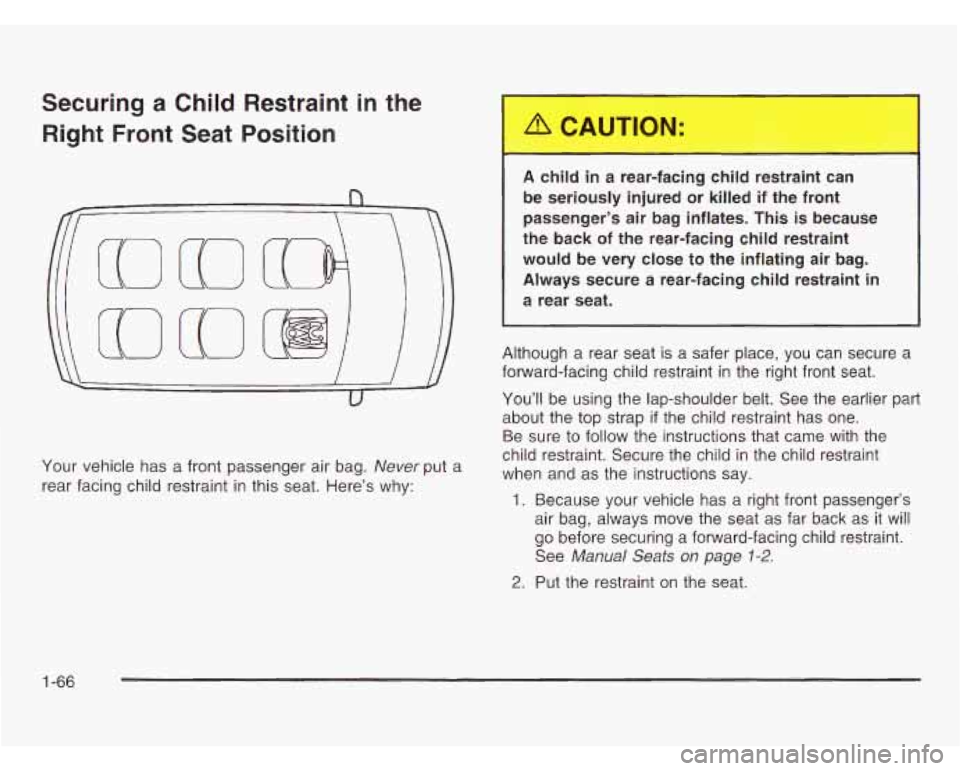
Securing a Child Restraint in the
Right Front Seat Position
n
Your vehicle has a front passenger air bag. Never put a
rear facing child restraint in this seat. Here’s why:
A cl ...- .. t a rear-facing child restraint can
be seriously injured or killed if the front
passenger’s air bag inflates. This
is because
the back
of the rear-facing child restraint
would be very close
to the inflating air bag.
Always secure a rear-facing child restraint in
a rear seat.
Although a rear seat is a safer place, you can secure a
forward-facing child restraint in the right front seat.
You’ll be using the lap-shoulder belt. See the earlier part
about the
top strap if the child restraint has one.
Be sure to follow the instructions that came with the
child restraint. Secure the child in the child restraint
when and as the instructions say.
1. Because your vehicle has a right front passenger’s
air bag, always move the seat as far back as it will
go before securing a forward-facing child restraint.
See
Manual Seats on page 1-2.
2. Put the restraint on the seat.
1-66
Page 75 of 466
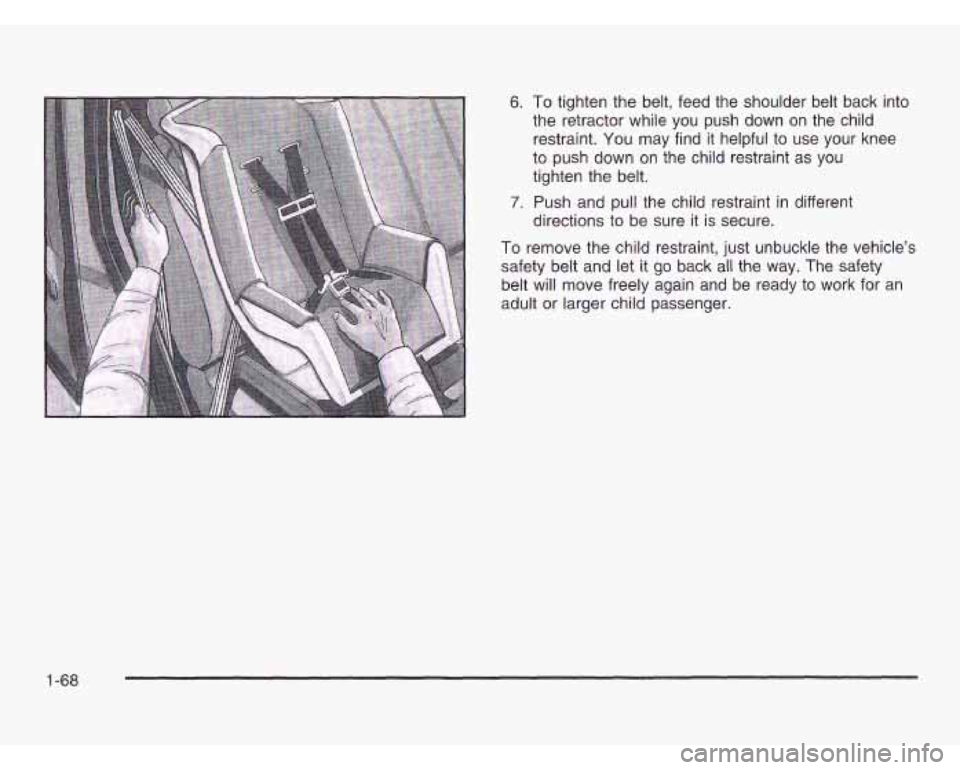
6. To tighten the belt, feed the shoulder belt back into
the retractor while you push down on the child
restraint. You
may find it helpful to use your knee
to push down on the child restraint as you
tighten the belt.
7. Push and pull the child restraint in different
directions to be sure it is secure.
To remove the child restraint, just unbuckle the vehicle’s
safety belt
and let it go back all the way. The safety
belt will move freely again and be ready to work for an
adult or larger child passenger.
1 -68
Page 77 of 466
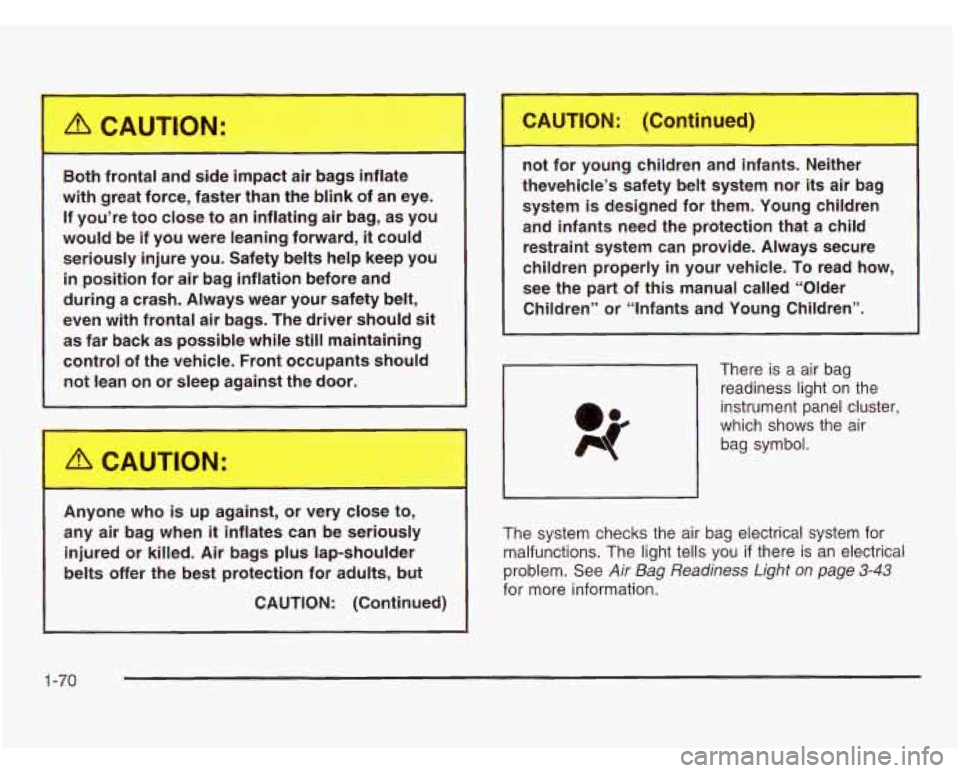
A CAUTION:
~~
Both frontal and side impact air bags inflate
with great force, faster than the blink of an eye.
If you’re too close to an inflating air bag, as you
would be
if you were leaning forward, it could
seriously injure you. Safety belts help keep you
in position for air bag inflation before and
during a crash. Always wear your safety belt,
even with frontal air bags. The driver
should sit
as far back as possible while still maintaining
control of the vehicle. Front occupants should
not lean on or sleep against the door.
nm.yone who
is up against, or very close to,
any air bag when
it inflates can be seriously
injured or killed. Air bags
plus lap-shoulder
belts offer the best protection for adults,
but
CAUTION: (Continued) not for young
-..ildl-.J and infants. ..,ither
thevehicle’s safety belt system nor its air bag
system
is designed for them. Young children
and infants need the protection that a child
restraint system can provide. Always secure
children properly
in your vehicle. To read how,
see the part of this manual called “Older
Children” or “Infants and Young Children”.
There is a air bag
readiness light on the
instrument panel cluster,
which shows the air
bag symbol.
- ~~
The system checks the air bag electrical system for
malfunctions. The light tells you
if there is an electrical
problem. See
Air Bag Readiness Light on page 3-43
for more information.
1 -70
Page 100 of 466
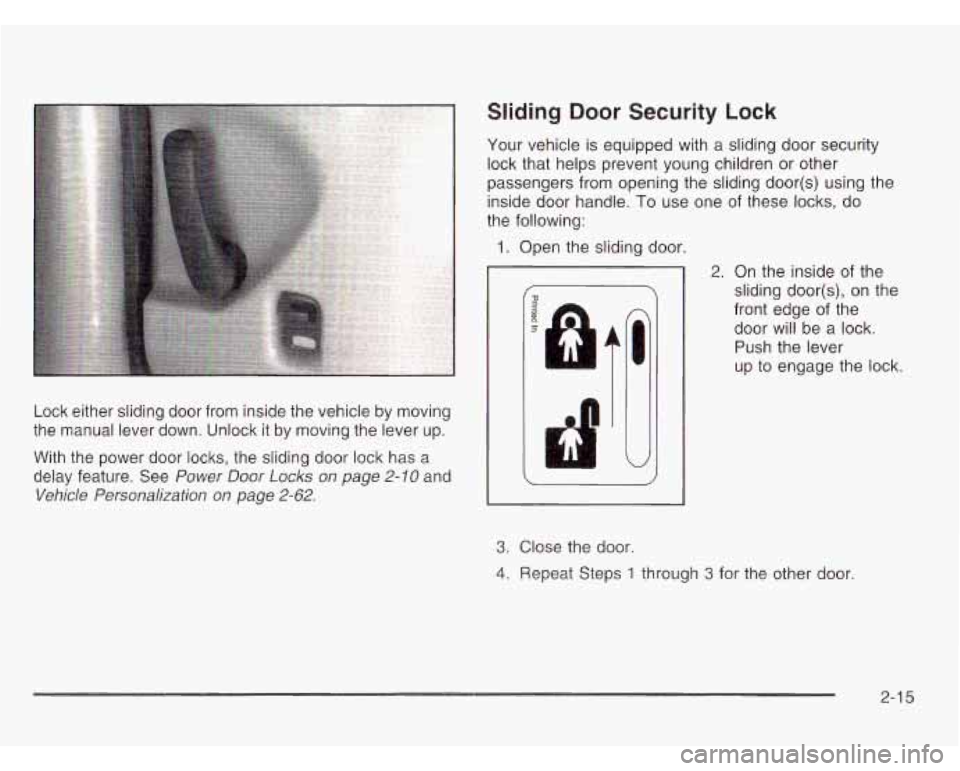
Lock either sliding door from inside the vehicle by moving
the manual lever down. Unlock
it by moving the lever up.
With the power door locks, the sliding door lock has a
delay feature. See
Power Door Locks on page 2-10 and
Vehicle Personalization on page 2-62.
Sliding Door Security Lock
Your vehicle is equipped with a sliding door security
lock that helps prevent young children or other
passengers from opening the sliding door(s) using the
inside door handle.
To use one of these locks, do
the following:
1. Open the sliding door.
2. On the inside of the
n 7 sliding door(s), on the
front edge of the
door will be a lock.
Push the lever
up to engage the lock.
3. Close the door.
4. Repeat Steps 1 through 3 for the other door.
2-1 5